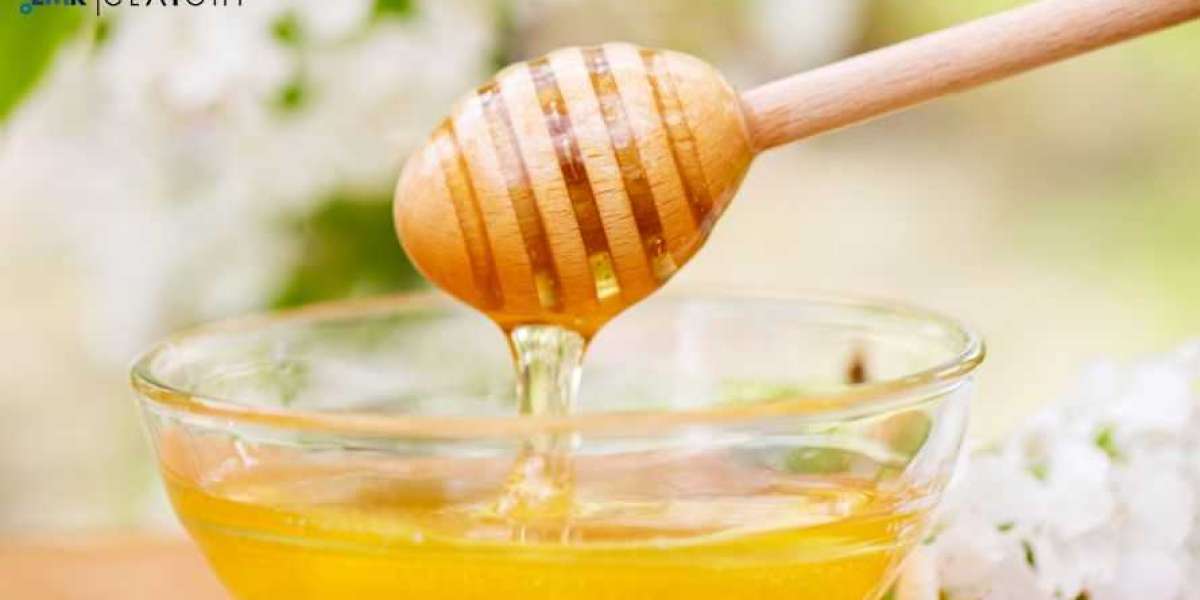Honey is a natural sweetener, prized for its taste, nutritional benefits, and versatility across various industries. It has been used for thousands of years, not only as food but also in medicine, cosmetics, and wellness products. Due to its broad range of applications and health benefits, honey continues to experience significant demand globally. The Honey Procurement Intelligence Report provides a comprehensive analysis of the honey market, offering insights into market trends, procurement strategies, supplier dynamics, and the challenges faced in sourcing high-quality honey.
What is Honey?
Honey is a viscous, sweet substance produced by bees from the nectar of flowers. Bees collect nectar and process it by secreting enzymes that break down the sugars, ultimately storing it in honeycombs. Honey comes in various forms, including raw honey, filtered honey, and honeycomb. Its flavor, color, and texture can vary depending on the floral source, region, and production methods.
Honey is rich in sugars like glucose and fructose, and contains trace amounts of vitamins, minerals, amino acids, and antioxidants. It is also known for its antimicrobial properties, making it a valuable ingredient in natural medicine.
Applications of Honey
Honey is used across a wide range of industries, including food and beverages, pharmaceuticals, cosmetics, and even agriculture. Some of the key applications include:
1. Food and Beverages
Honey is widely used as a sweetener in various food products, including baked goods, cereals, spreads, dressings, and beverages. It is also popular as a natural alternative to refined sugar in cooking and as a topping for fruits, yogurt, and granola. Additionally, honey is used in beverages such as honey tea, mead, and smoothies for its natural sweetness and health benefits.
2. Pharmaceuticals and Natural Medicine
Honey has been used for its medicinal properties for centuries. It is a natural remedy for sore throats, coughs, and digestive issues. Honey's antimicrobial properties make it useful in wound care, particularly in the form of honey bandages and ointments. Manuka honey, sourced from the nectar of the Manuka bush in New Zealand, is especially known for its potent antibacterial properties.
3. Cosmetics and Personal Care
Honey is commonly found in cosmetics, skincare, and haircare products due to its moisturizing, soothing, and anti-inflammatory properties. It is used in creams, lotions, shampoos, conditioners, and face masks. Honey's natural humectant properties help retain moisture in the skin, making it a popular ingredient in anti-aging and hydrating products.
4. Agriculture
Honey plays a role in agriculture as well, particularly through its role in pollination. Beekeepers provide pollination services to farmers, enhancing crop yields. Additionally, bees help in the production of honey by pollinating the flowers that produce nectar, which forms the foundation for honey production.
Get a Free Sample Report with Table of Contents@
Market Trends in Honey Procurement
The honey market has seen several key trends in recent years, driven by evolving consumer preferences, market demands, and global supply chain dynamics. Some of the major trends include:
1. Growing Demand for Natural and Organic Honey
Consumers are increasingly seeking natural and organic products, and honey fits into this trend perfectly. Organic honey, produced from pesticide-free flowers, is becoming more popular, particularly among health-conscious consumers. Honey labeled as raw or unfiltered, with minimal processing, is also in demand as it is perceived to retain more of its natural nutrients and beneficial properties.
2. Rising Popularity of Specialty Honeys
While traditional honey remains popular, there is a growing interest in specialty honeys such as Manuka honey, acacia honey, and wildflower honey. Manuka honey, in particular, is gaining attention for its unique health benefits, particularly its antibacterial properties. As consumers become more discerning about the types of honey they purchase, there is an increasing demand for high-quality, niche honey varieties.
3. Sustainability and Ethical Sourcing
Sustainability is a major focus in the honey industry, especially as concerns about bee population decline and environmental impacts increase. Many companies and consumers are prioritizing honey that is ethically sourced, with an emphasis on supporting local beekeepers and sustainable farming practices. Certifications like Fair Trade and Organic play an important role in ensuring the honey supply chain is ethical and sustainable.
4. Health and Wellness Focus
Honey is increasingly promoted as a healthy alternative to refined sugar, with growing recognition of its antimicrobial and antioxidant properties. Consumers are seeking honey for its potential health benefits, including its use as a natural remedy for colds, allergies, and digestive issues. Honey's popularity in health-conscious diets, such as paleo and keto diets, is also driving demand.
5. Geopolitical Factors and Supply Chain Disruptions
Honey production is highly dependent on geographic factors, including climate conditions, the availability of floral sources, and local regulations. Honey-producing regions, such as New Zealand, Argentina, and the United States, face challenges like drought, changing agricultural practices, and fluctuating labor costs. These factors can impact supply and cause price volatility in the honey market.
Procurement Challenges in Honey Sourcing
While the demand for honey is strong, there are several challenges that businesses face in procuring high-quality honey. Some of the key challenges include:
1. Fluctuating Prices
Honey prices can fluctuate significantly based on factors such as climate conditions, harvest yields, and global demand. For instance, adverse weather conditions can lead to poor harvests, driving up prices. Additionally, global trade dynamics and exchange rates can impact the cost of honey. Procurement professionals must stay informed about these factors to mitigate price volatility.
2. Quality Control
The quality of honey can vary greatly depending on its origin, production methods, and processing techniques. Impurities, such as added sugars or contaminants, can affect the honey's purity and quality. It is essential for businesses to work closely with suppliers who can guarantee the authenticity and high quality of the honey they provide.
3. Counterfeit and Adulterated Honey
Adulteration and fraud are significant issues in the honey industry. Some suppliers may dilute honey with cheaper sweeteners, such as high-fructose corn syrup, or mislabel the origin of the honey. This poses a significant risk for companies that rely on genuine, high-quality honey. Implementing rigorous quality control measures and sourcing from certified, trustworthy suppliers is crucial to avoid this issue.
4. Sustainability and Ethical Sourcing
As mentioned, sustainability and ethical sourcing are growing concerns in the honey industry. Beekeeping practices that are harmful to bee populations or the environment can harm the integrity of honey sourcing. Businesses must ensure that their suppliers follow ethical practices, including sustainable farming, proper beekeeping methods, and certifications that confirm the honey is sourced responsibly.
5. Supply Chain Risks
The honey supply chain is often affected by geopolitical issues, such as trade disputes, import/export regulations, and natural disasters. For instance, the trade tensions between major honey-producing countries, such as China and the United States, can disrupt honey supply and lead to price fluctuations. Procurement professionals must manage these risks by diversifying suppliers and exploring alternate sourcing strategies.
Procurement Intelligence in Honey Sourcing
Procurement intelligence is crucial in navigating the complexities of the honey market. By leveraging data and insights, businesses can make more informed decisions, reduce risks, and optimize sourcing strategies. The role of procurement intelligence in honey sourcing includes:
1. Market Insights and Trend Forecasting
Procurement intelligence tools can help businesses track market trends, such as changes in honey prices, consumer demand, and global production conditions. This enables companies to forecast market shifts, adjust procurement strategies, and ensure that they secure the best possible prices for honey.
2. Supplier Evaluation and Risk Management
With numerous honey suppliers worldwide, procurement intelligence allows businesses to evaluate potential suppliers based on factors such as quality, reliability, price, and sustainability practices. This helps businesses mitigate risks and select the right suppliers that align with their procurement goals.
3. Cost Optimization
Procurement intelligence can identify opportunities to reduce costs by analyzing historical data, identifying cheaper suppliers, and negotiating better terms. Businesses can also optimize shipping and logistics costs by leveraging insights into shipping routes and delivery schedules.
4. Supply Chain Transparency
With procurement intelligence, companies gain better visibility into their honey supply chains. This transparency allows them to monitor honey sources, track shipments, and ensure compliance with sustainability certifications. It also enables businesses to react more swiftly to disruptions or delays in the supply chain.
5. Sustainability and Compliance Monitoring
Many businesses now prioritize sustainability in their procurement decisions. Procurement intelligence tools can help businesses monitor the sustainability practices of their honey suppliers, ensuring they meet ethical sourcing standards and certifications. This is especially important for companies that want to align their procurement strategies with corporate social responsibility (CSR) goals.
Procurement Strategies for Honey Sourcing
To ensure the efficient procurement of high-quality honey, businesses should implement strategies that address market dynamics, quality control, and supply chain risks. Some key procurement strategies for honey sourcing include:
1. Diversification of Suppliers
To mitigate risks associated with relying on a single supplier or region, businesses should diversify their supplier base. Sourcing honey from different geographic locations helps reduce the impact of regional disruptions, such as adverse weather or local regulatory changes.
2. Building Long-Term Relationships with Suppliers
Establishing long-term partnerships with trusted honey suppliers can lead to more favorable pricing and consistent quality. Strong relationships help businesses secure priority access to high-quality honey and ensure that suppliers adhere to agreed-upon standards.
3. Sustainability Certification and Auditing
As sustainability becomes a key concern, businesses should prioritize suppliers with certifications such as Fair Trade, Organic, and Rainforest Alliance. These certifications ensure that honey is ethically sourced and produced with minimal environmental impact.
4. Leveraging Bulk Purchases
To reduce costs and ensure a steady supply, businesses can negotiate bulk purchasing agreements with suppliers. By securing large quantities of honey at fixed prices, businesses can protect themselves from price volatility and ensure that they meet demand without shortages.
5. Monitoring Supply Chain Risks
Effective monitoring of the supply chain can help businesses identify risks early and take corrective actions before disruptions occur. Procurement intelligence tools can provide real-time tracking and alerts, enabling businesses to address potential issues promptly.
Related Reports







